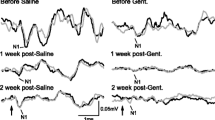Summary
Local anesthetics, even if applied to the outer ear canal, may still enter the middle ear, running the risk of penetrating the round window. To elucidate the effect of certain topical anesthetics on the inner ear, the round window niche in the laboratory rat's middle ear was exposed separately to lidocaine, lidocaine-prilocaine and phenol. Auditory brain-stem responses (ABR) were recorded at 2, 4, 6, 8, 12, 16, 20, and 31.5 kHz before the application, and 24 h, 3 weeks, 2 months and 6 months after exposure. After terminating the 6-month ABR measurements, the animals were sacrificed and the temporal bones fixed and decalcified for light microscopic analysis. All three drugs affected the ABR thresholds and the cochlear morphology with a pattern characteristic for each drug. At 24 h, all three substances caused severe impairment of ABR thresholds, followed by a period of restitution lasting up to 2 months. Even 6 months after exposure, the ABR thresholds at and above 12 kHz were impaired, as compared with the pre-treatment level, for all substances tested. In the lower frequencies the original ABR threshold was reached in the order: (1) lidocaine, (2) lidocaine-prilocaine, (3) phenol. The cochlear structures were unaffected by lidocaine, whereas lidocaine-prilocaine and phenol caused morphological damage which was most pronounced after exposure to phenol. The heterogeneity of the changes in the ABR thresholds suggests differences in the mechanism of action of each type of local anesthetic investigated. The effects following lidocaine were transient. However, clinicians must be aware of the ototoxic potential of both lidocaine and phenol.
Similar content being viewed by others
References
Anniko M (1976) The cytocochleogram in atoxyl treated guinea pigs. Acta Otolaryngol (Stockh) 82:70–81
Anniko M (1981) Decalcification effects on the fine structure of the mammalian inner ear. Micron 12:267–278
Anniko M (1985) Principles in cochlear toxicity. Arch Toxicol [Suppl] 8:221–239
Anniko M, Lundquist P-G (1980) Temporal bone morphology after systemic arterial perfusion or intralabyrinthine in situ immersion. 1. Hair cells of the vestibular organs and the cochlea. Micron 11:73–83
Anniko M, Schmidt S-H (1988) The ototoxic potential of EMLA, a new local anesthetic for the tympanic membrane. Acta Otolaryngol (Stockh) 105:255–265
Békésy G von (1960) Experiments in hearing. McGraw Hill. New York
Borg E (1982) Auditory thresholds in rats of different age and strain. A behavioural and electrophysiological study. Hear Res 8:101–115
Borg E, Engström B (1983) Hearing thresholds in the rabbit. Acta Otolaryngol (Stockh) 95:19–26
Dum N, Schmidt U, Wedel H von (1981) Scalp distribution of the auditory evoked brainstem potentials in the guinea pig during monaural and binaural stimulation. Hear Res 5:271–284
Henry K (1979) Auditory brainstem volume-conducted responses: origins in the laboratory mouse. J Am Audiol Soc 4: 173–178
Hultcrantz M, Anniko M, Borg E (1985) Structure and function of the adult cochlea following prenatal irradiation. Acta Otolaryngol (Stockh) [Suppl] 425:1–31
Jewett DL (1970) Volume-conducted potentials in response to auditory stimuli as detected by averaging in the cat. Electroencephalogr Clin Neurophysiol 28:609–618
Karma P, Palva T, Kouvalainen K, Ktirjd J, Mäkeld PH, Prinssi V-P, Ruuskanen O, Launiala K (1987) Finnish approach to the treatment of acute otitis media. Ann Otol Rhinol Laryngol [Suppl] 129:1–19
Laurent C, Hellstrom S, Anniko M (1988) Inner ear effects of exogenous hyaluronan in the middle ear of the rat. Acta Otolaryngol (Stockh) 105:273–280
Liberman MC, Mulroy MJ (1982) Acute and chronic effects of aoustic trauma: cochlear pathology and auditory nerve pathophysiology. In: Hamernick RP, Henderson D, Salvi R (eds) New perspectives on noise induced hearing loss. Raven Press, New York, pp 105–135
Lundquist P-G (1976) Aspects on endolymphatic sac morphology and function. Arch Otorhinolaryngol 212: 231–240
Schacht J (1986) Molecular mechanisms of drug-induced hearing loss. Hear Res 22:297–304
Schmidt S-H, Hellström S (1986) Late effects of local anaesthetics on tympanic membrane structure. A study in the rat. Am J Otolaryngol 7: 346–352
Schmidt S-H, Hellström S, Carlsöö B (1984) Short term effects of local anaesthetic agents on the structure of the rat tympanic membrane. Arch Otorhinolaryngol 240:159–166
Schmidt S-H Hellström S, Carlsob B (1986) Fine structure of the rat tympanic membrane after treatment with local anesthetics. Acta Otolaryngol (Stockh) 101: 88–95
Simmons FB, Glattke TJ, Downie DB (1973) Lidocaine in the middle ear. A unique cause of vertigo. Arch Otolaryngol 98: 42
Spandow O, Anniko M, Hellström S (1989) Hydrocortisone applied into the round window niche causes electrophysiological changes of the inner ear. ORL] 51:94–102
Spandow O, Anniko M, Hellstrom S (1989) Inner ear disturbances following inoculatin of endotoxin into the middle ear. Acta Otolaryngol (Stockh) 107:90–96
Tran Ba Huy P, Manuel C, Meulemans A, Sterkers O, Amiel C (1981) Pharmacokinetics of gentamicin in perilymph and endolymph of the rat as determined by radioimmunoassay. J Infect Dis 143:476–486
Wenngren B-I, Anniko M (1988) A frequency specific auditory brainstem response technique exemplified in the determination of age related ABR thresholds. Acta Otolaryngol (Stockh) 106:238–243
Wersäll J (1956) Studies on the structure and innervation of the cristae ampullares in the guinea pig. Acta Otolaryngol (Stockh) [Suppl] 126:185
Wersäll J, Lundquist P-G, Björkroth B (1969) Ototoxicity of gentamicin. J Infect Dis 119:410–416
Wersäll J, Björkroth B, Flock A, Lundquist P-G (1973) Experiments on ototoxic effects of antibiotics. Adv OtorhinoIaryngol 20:14–42
Author information
Authors and Affiliations
Rights and permissions
About this article
Cite this article
Schmidts, S.H., Anniko, M. & Hellström, a. Electrophysiological effects of the clinically used local anesthetics lidocaine, lidocaine-prilocaine and phenol on the rat's inner ear. Eur Arch Otorhinolaryngol 248, 87–94 (1990). https://doi.org/10.1007/BF00240226
Received:
Accepted:
Issue Date:
DOI: https://doi.org/10.1007/BF00240226




